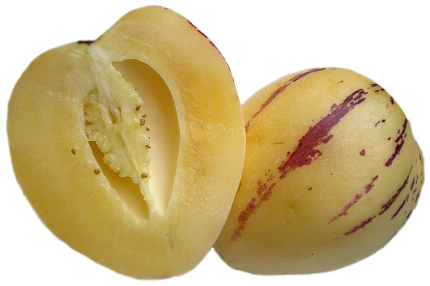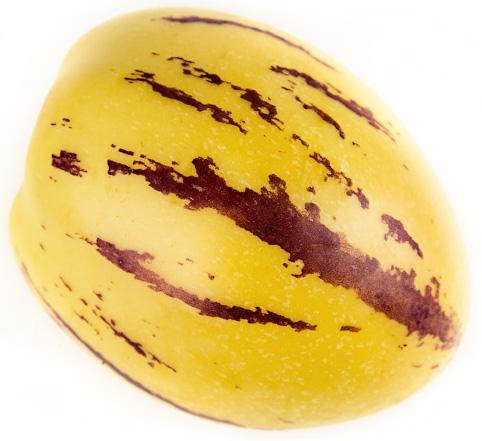

Melon Pear

Solanum. (Latin name for this plant.) NIGHTSHADE. Solanaceae. About 1400 species of herbs, shrubs, trees, or occasionally vines. Leaves simple, entire, lobed or parted. Inflorescence cymose, umbellate, paniculate or racemose; calyx campanulate or rotate, 5-dentate, sometimes enlarged in fruit; corolla rotate or broadly campanulate, regular, 5-angled or 5-lobed, tube very short, limb plaited in bud; stamens 5, all fertile, filaments very short, anthers oblong to linear, connivent or connate around style, opening by terminal pores or short terminal clefts; ovary 2-celled, stigma small. Fruit a berry, fleshy or coriaceous; seeds numerous, more or less flattened. Cosmopolitan, particularly Tropical America. CultivationIn so large a genus, the range of habit and ecological niche is diverse, from upland forest, to semi-desert, coastal and riverside habitats although Solanum species are primarily plants of warm regions, the majority showing at least some degree of frost sensitivity. The genus includes large numbers of weeds that occur commonly on disturbed soils, their significance in gardens being that they provide alternative hosts for the diseases affecting cultivated species, in particular the potato, Solanum tuberosum. Several of the hardy European native nightshades, such as the poisonous Solanum dulcamara, are offered by wild flower specialists, but these are perhaps best left in the damp shaded woodland where they belong an should not be given any room in, for example, the family garden. Ornamental shrubs, climbers and perennials. Those most commonly cultivated as ornamentals include a number of vigorous climbers and lianes used to clothe pergola, trellis and walls (with support), in the open garden in warm temperate and subtropical regions or, in cooler zones, in the intermediate glasshouse. The hardiest climbers include the semi-evergreen Solanum crispum (to at least -5ºC) and its slightly tougher cultivar Glasnevin (-10ºC), along with the more tender Solanum jasminoides and its handsome cultivar Album (although this last is known to have survivied to -10ºC. These are well suited to a warm and sheltered south-facing or southwest-facing wall in cool temperate gardens. Neither is exacting in soil requirements, and Solanum crispum is tolerant of chalk soils. Solanum wendlandii, Solanum pensile and Solanum seaforthianum are handsome climbers requiring intermediate to hot glasshouse conditions in temperate climates. All of the climbing species thrive in full sun, but require some protection from the fiercest summer sun to avoid bleaching the foliage, especially under glass. Grow in the glasshouse border or in large pots in a medium-fertility, loam-based mix, providing a minimum temperature of 5-10ºC for frost-sensitive species, 10-15ºC for tropical species. Ventilate freely as temperatures rise above 15ºC, water plentifully and feed established plants when in full growth, reducing water in winter. Tie in periodically as growth progresses. Prune immediately after flowering, or in spring before growth begins, shortening strong stems and removing weak and crowded shoots. Propagate by seed in spring of by softwood or greenwood cuttings in a closed case with bottom heat or under mist. 
In cooler regions, some frost-tender shrubby species, including Solanum wrightii and Solanum valdivense, are attractive specimens for large pots in the cool to intermediate glasshouse or conservatory, responding to the same cultural regime as that outlined for climbing species. Many of these are grown in subtropical and tropical gardens for their brightly coloured fruit or handsome form, including Solanum aculeatisimum, Solanum aethiopicum, Solanum eleaganifoium, Solanum giganteum, Solanum integrifolium, Solanum marginatum, Solanum pyracanthum, Solanum robustum and Solanum sisybrifolium. In colder climates, some may be grown as frost-tender annuals for flower or fruit, among them Solanum aethiopicum, Solanum aculeatissimum and Solanum laciniatum; others, such as Solanum sisymbrifolium, will be perennial in mild areas where temperatures seldom drop below freezing. Shrubby species with a degree of cold tolerance, such as Solanum aviculare and Solanum laciniatum, may be tried in borders at the base of a warm wall, covered with sacking or deep mulch to protect the rootstock in winter; they will sprout from the base in spring. Solanum muricatumPEPINO; MELON PEAR; MELON SHRUB. Herb or shrub, erect or ascending, to 1m or more; stem generally branched. Leaves to 15 x 4.5cm, simple or with 1-2 pairs of lateral leaflets, ovate-lanceolate, apex obtuse to acuminate, base rounded and oblique; petiole 3-7cm. Inflorescence pseudoterminal, few-flowered to 12-flowered; peduncle simple or forked, 5-8cm; pedicels 0.5-1.5cm, enlarged in fruit; calyx 4-7mm, deeply lobed; corolla rotate, to 4cm diameter, violet-purple or white with purple markings; anthers 5-6mm. Fruit pendent, to 10 x 6cm, ovoid to ellipsoid, white or pale green with purple varigations, flesh yellow, juicy, aromatic, edible. Andes. ‘Colossal’: fruit very large. ‘Ecuadorian Gold’: long season. ‘El Camino’: almost seedless. ‘Rio Bamba’: good flavour, climbing or trailing. ‘Temptation’: large. ‘Vista’: vigorous, heavy cropper, self-fertile. Z9.
|
Home
Grow Herbs
Grow Nuts
Grow Vegetables
Cyberian Index
If you like this website and want one of your own contact
Cyberian All information correct at
time of publication and open to updates as necessary. No part of this website,
or its vectors, may be produced in any shape or form, using any type or design
of medium, system, equipment or otherwise without the prior written consensual
notice of the Cyberian. Any breach of these requirements will result in the
appropriate action. If in doubt, e-mail contact is recommended.
Some components of this website were obtained as open-source software and are
used in the same non-profit manner on this website.